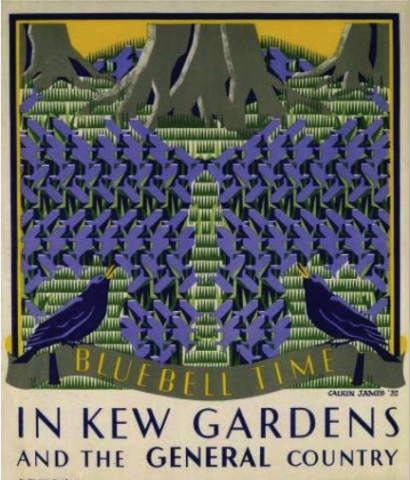
“Art for All” Tracks Modern Posters
“Art for All, British Posters for Transport,” the exhibition at the Yale Center for British Art, New Haven, CT is aptly named. Certainly, posters are the most democratic form of art. Plastered on walls in public places, they’re available to everyone, as is the Yale Center for British Art, which charges no admission.
Posters are decorative eye-candy. And this is one sweet show. But posters are also a powerful economic, social and political tool. The image is the message. Its appeal is basic. It can be understood quickly and by anyone.
“Art for All” surveys the various London campaigns that enticed people to use the most democratic public transportation. Sound familiar? But the Brits are no Johnny-come-lately when it comes to support for public transportation. Led by Frank Pick, the London Underground (later known as the London Transport) commissioned its first poster in 1908.
Such accomplished artists as Edward McKnight Kauffer, Frederick Herrick, Hans Schleger, and Anna Zinkeisen produced posters with images that are familiar the world over. Their contributions include the ubiquitous railway map with different routes distinguished by color – the red line, the blue line, the orange line, etc.
In addition to encouraging commuters and shoppers to use public transportation, the posters promoted rail use by showcasing London destinations as exotic and exciting places. Ernest Michael Dinkel’s poster from 1933, “Visit The Empire,” depicts scenes from Africa, Malaya, India, Australia, Burma, Nigeria, and the East Indies under a banner proclaiming “The Wealth, Romance, and Beauty of the Empire.” But the purpose was not to highlight the pleasure of foreign travel. Dinkel’s art bullets the names of the stations at which passengers could disembark for Australia House, the Imperial Institute, Madame Tussauds, and India House. It’s a reminder, now, of how far the British Empire once extended.
Some things, however, have not changed. As early as 1924, the British educated passengers on the value and importance of rail travel. An Irene Fawkes poster, “What It Takes to Move the Passengers,” pictures a relaxed and dapper, pipe-smoking gentleman who sits on a flat, wheeled platform. A trunk labeled “taxes” serves as his backrest. A group of tiny men strain to pull him along the tracks.
“The Problem of The Underground,” it notes is that in 1923, it cost 184,000 pounds in taxes and required 234,000 tons of coal, 71,000 gallons of oil, 10,000 staff , 6,000 tons of iron and steel, and 2000 tons of tickets to move 306,000,000 passengers on the Underground Electric Railways of London (U.E.R.L.).
There’s lots to enjoy in this exhibition. The colorful posters in the collection are an illustrated history of the evolving art movements of the 20th century, the changes in printing technology, the improvements in transportation, the range of recreation and leisure activities, and clothing styles in fashions.
The British Transport posters gave women an all too rare opportunity to show their art in public places. At least 164 women designed posters. Irene Fawkes, who created “The Problem of The Underground,” provided at least 25 additional posters.
The influence of British posters made its way across the pond to public transportation systems in this country. The Chicago Rapid Transit Company, consolidated by British-born Samuel Insul, commissioned several posters. “What do You Give,” a bright yellow poster from 1929 by Willard Frederic Elmes, addresses the chronic problem of littering in the stations. A junkman dressed in a baggy brown coat stands beside his cart and picks up clutter. The print notes, “Wasters dump a good big pay roll into every junk yard. Waste Hinders Everybody.”
“Art for All,” on view through August 15 at the Yale Center for British Art is little more than a two hour drive from Boston. Or, you could take public transportation.
Image courtesy of the Yale Center for British Art: Margaret Calkin James, Bluebell Time in Kew Gardens, 1931, lithograph, London Transport Museum, © TfL from the London Transport Museum Collection

